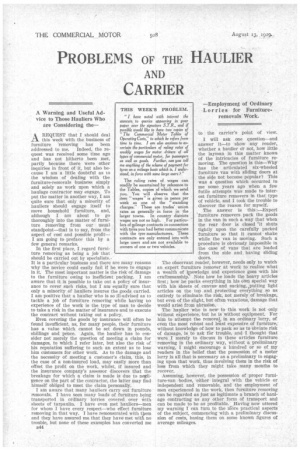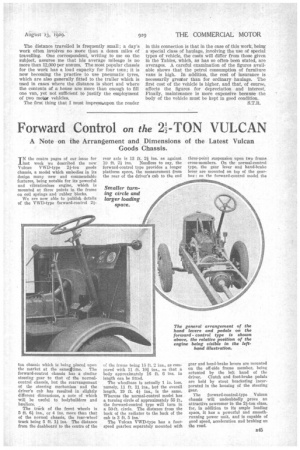PROBLEMS OF THE HAULIER
Page 70

Page 71

If you've noticed an error in this article please click here to report it so we can fix it.
AND
CARRIER
A Warning and Useful Advice to Those Hauliers Who are Considering the— AREQUEST that I should deal this week with the business of furniture 'removing has been addressed to me. Indeed, the request was received some time ago and has not hitherto been met, partly because there were other inquiries in front of it, but also because I am a little doubtful as to the wisdom of dealing with the furniture-removals business simply and solely as work upon which a haulage contractor may engage. To put the matter in another way, I am quite sure that only a minority of hauliers should engage itself to move household furniture, and, although I am about to go thoroughly into the matter of furniture removing from our usual standpoint—that is to say, from the aspect of cost and possible profit— I am going to preface this by a few general remarks.
In the first place, I regard furniture removing as being a job that
should be carried out by specialists.
It is a particular business and there are many reasons why the novice could easily fail if he were to engage in it. The most important matter is the risk of damage to the furniture owing to inefficient packing. I am aware that it is possible to take out a policy of insurance to cover such risks, but I am equally sure that only a minority of hauliers insures the goods carried. I am positive that a haulier who is so ill-advised as to tackle a job of furniture removing while having no experience of the work is the type of man to decide to take a risk in the matter of insurance and to execute the contract without taking out a policy.
Even covering the goods by insurance will often be found insufficient, as, for many people, their furniture has a value which cannot be set down in pounds, shillings and pence. Again, the haulier has to consider not merely the question of meeting a claim for damages, to which I refer later, but also the risk of his reputation suffering to such an extent as to lose him customers for other work. As to the damage and the necessity of meeting a customer's claim, this, in the case of a non-insured load, may easily more than offset the profit on the work, whilst, if insured and the insurance company's assessor discovers that the breakage for which a claim is made is due to negligence on the part of the contractor, the latter may find himself obliged to meet the claim personally.
I am aware that many hauliers carry out furniture removals. I have seen many loads of furniture being transported in ordinary lorries covered over With sheets of tarpaulin. I have even met hauliers—men for whom I have every respect—who effect furniture removing in that way. I have remonstrated with tDem and they have assured me that they have met with no trouble, but none of these examples has converted me s44 to the carrier's point of view.
I will ask one question—and answer it—to show any reader, • whether a haulier or not, how little the layman in this matter knows of the intricacies of furniture removing. The question is this—Why has the articulated six-wheeled furniture van with sliding doors at the side not become popular? This was a question which occurred to me some years ago when a few futile attempts was made to interest furniture removers in that type of vehicle, and I took the trouble to discover the reason for myself.
The answer is this :—Expert 'furniture removers pack the goods in the van in such a way that when the rear door is closed 4it shuts tightly upon the carefully packed furniture so that it cannot shake while the van is moving. Such a procedure is obviously impossible in the case of vans that are loaded from the side and having sliding
The observant reader, however, needs only to watch an expert furniture remover at work to realize what a wealth of knowledge and experience goes with his craftsmanship'? Note how he loads the heavy articles first; how he packs everything in his own special way with his sheets of canvas. and sacking, putting light articles on the top and protecting everything so as entirely to eliminate the risk, not merely of breakage, but even of the slight, but often vexatious, damage that would arise from abrasion.
The haulier who is new to this work is not only without experience, but he is without equipment. For him to attempt the removal, in an ordinary lorry, of even the most robust and last expensive of furniture, without knowledge of how to pack so as to obviate risk of flamage, is to ask for trouble, and I thought that were I merely to discuss in these articles furniture removing in the ordinary way, without a preliniinary warning, I might encourage a hundred or so of my readers in the belief that the possession of a motor lorry is all that is necessary as a preliminary to engaging upon that work, thus involving them ha the risk of loss from which they might take many months to recover.
Assuming, however, the possession of proper furniture-van bodies, either integral with the vehicle or independent and removable, and the employment of men experienced in the work, then furniture removing can be regarded as just as legitimate a branch of haulage contracting as any other form of transport and can be made to be as profitable. Having now uttered my warning I can turn to the //Tore practical aspects of the subject, commencing with a preliminary discussion of costs, basing them on some known figures of average mileages. The distance travelled is frequently small; a day's work often involves no more than a dozen miles of travelling. Oue correspondent, writing to me on the subject, assures me that his average mileage is no more than 12,000 per annum. The most popular chassis for the work has a load capacity for four tons ; it is now becoming the practice to use pneumatic tyres, which are also generally fitted to the trailer which is used in cases where the distance is short and where the contents of a house are more than enough to fill one van, yet not sufficient to justify the employment of two motor vehicles.
The first thing that I must impressuupon the reader in this connection is that in the case of this work, being a special class of haulage, involving the use of special types of vehicle, the costs will differ from those given in the Tables, which, as has so oftenbeen stated, are averages. A careful examination of the figures available shows that the petrol consumption of furniture vans is high. In addition, the cost of insurance is necessarily greater than for ordinary haulage. The first cost of the vehicle is higher, and that, of course, affects the figures for depreciation and interest. Finally, maintenance is more expensive because the body of the vehicle must be kept in good condition.




















































































































